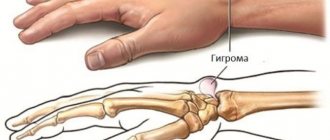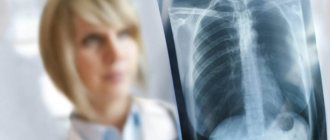Lungs
Lung structure
The lungs are paired organs located in the chest cavity. They consist of lobes: the right lung contains three lobes, the left - two. Lung tissue consists of bubbles - alveoli, in which a vital process occurs - gas exchange between blood and atmospheric air.
The lung is covered with a membrane - the pleura, which passes from the surface of the lungs to the inner walls of the chest. A pleural cavity is formed between the two layers of the pleura, the pressure in which is lower than atmospheric (it is called negative pressure), which is of fundamental importance for the act of inhalation and exhalation.
Gas exchange in the lungs and tissues
The air moves along the airways and finally reaches the smallest structure of the lung - the pulmonary vesicle, or alveoli. The wall of the alveoli is intertwined with a dense network of capillaries - vessels with a thin wall through which gases diffuse: carbon dioxide leaves the blood into the alveoli, and oxygen enters the blood from the alveoli.
Oxygen dissolved in the blood reaches the internal organs and tissues of the body through the blood vessels. I note that moving through the blood, gases form compounds with hemoglobin in red blood cells:
- Oxygen (O2) - oxyhemoglobin
- Carbon dioxide (CO2) - carbhemoglobin
- Carbon monoxide (CO) - carboxyhemoglobin
The combination of hemoglobin with carbon monoxide is much more stable than the others: carbon monoxide easily wins the competition with oxygen and takes its place. This explains the severe consequences of carbon monoxide poisoning, which quickly accumulates during a fire in a confined space.
As the blood gives up carbon dioxide and takes in oxygen, it turns from venous blood (poor in oxygen) into arterial blood. In tissues, the reverse process occurs: cells need oxygen necessary for tissue respiration, and carbon dioxide, a byproduct of metabolism, requires removal from the cell into the blood.
I often ask students, “What moves the gas, what causes, for example, oxygen to move first from the alveoli to the blood, and in the tissues from the blood to the cells?” Remember that this driving force is the difference in partial pressure of gases.
The partial pressure of a gas is that part of the total volume of gas that falls on the share of this gas. I do not recommend that you memorize the table above, but it is quite good for understanding.
Note that the partial pressure of oxygen in the alveoli is 100-110, and in the venous blood of the capillary that encircles the wall of the alveoli, the oxygen pressure is 40. Thus, oxygen rushes from an area of higher pressure to an area of lower pressure - from the alveoli into the blood.
The ongoing movements of gases can be easily recorded by measuring the concentration of gases in the air inhaled and exhaled by a person. You probably won't need much of this information, but I encourage you to remember that the ambient air contains 21% oxygen and 0.03% carbon dioxide - this is important information.
The liquid covering the walls of the alveoli - surfactant - is important in the transport of gases. Initially, oxygen dissolves in the surfactant and only then diffuses through the capillary wall, entering the blood. Surfactant also prevents the walls of the alveoli from sticking together (collapsing) during exhalation.
Vital capacity of the lungs
One of the physiologically important indicators is vital capacity (VC). Vital capacity is the maximum amount of air that a person can exhale after the deepest breath.
This indicator is very variable; the average vital capacity of an adult is about 3500 cm3. In athletes, vital capacity is 1000-1500 cm3 more, and in swimmers it can reach 6500 cm3. The greater the vital capacity, the more air enters the lungs and oxygen enters the circulatory system, which is very important for tissue cells during sports.
Vital vital capacity is easily measured using a special device - a spirometer (from the Latin spirare - to breathe).
Mechanism of pulmonary respiration
Between the outer surface of the lung and the walls of the chest there is a pleural cavity, which plays a vital role in the process of inhalation and exhalation, and also reduces friction of the lungs during breathing movements.
The pressure in the pleural cavity is always 5-7 mm lower. rt. Art. atmospheric pressure, so the lungs are constantly in an expanded state, fastened through the pleura to the walls of the chest cavity.
Imagine: the lung is pulled up to the pleura, which is attached to the chest. And the chest constantly makes breathing movements, expanding and contracting, thus the lung follows the respiratory movements of the chest.
It remains to figure out how these respiratory movements occur? The reason for this is the contraction and relaxation of the intercostal muscles, as a result of which the chest rises and falls, respectively. Now we will discuss in detail the mechanism of inhalation and exhalation.
When inhaling, the external intercostal muscles contract, while the ribs rise, and the sternum moves forward - the chest expands in the anteroposterior and frontal (to the sides) directions. The diaphragm is a respiratory muscle; during inhalation it contracts and moves down: the chest expands in the vertical direction.
When you exhale, the internal intercostal muscles contract, the ribs lower, the sternum moves back - the chest narrows in the anteroposterior and frontal (to the sides) directions. During exhalation, the diaphragm relaxes and rises: the chest narrows in the vertical direction. Thanks to these movements, inhalation and exhalation are carried out.
Can we take control of our breathing? Easily. But we don’t always control it even during the day, let alone at night. The breathing process is controlled by the respiratory center located in the medulla oblongata of the brain. The respiratory center is automatic - periodically impulses themselves flow to the respiratory muscles, for example, during sleep.
The composition of the blood greatly affects the intensity of breathing. Numerous experiments have shown that an increase in CO2 concentration stimulates the respiratory center. This can explain the increase in breathing during physical activity, for example, running, when CO2 is actively formed in the muscle cells of the legs and enters the blood, breathing becomes more frequent reflexively.
The reflex regulation of breathing is most clearly demonstrated by the experiment with cross circulation, in which the circulatory systems of two dogs are connected. When the trachea is compressed, the first dog stops breathing, and carbon dioxide stops being removed from the blood - its concentration in the blood increases, which leads to shortness of breath (rapid breathing) in the second dog.
Pneumothorax
Normally, the pressure in the pleural cavity is negative, which stretches the lungs. However, with injuries to the chest, the integrity of the pleural cavity may be disrupted: in this case, the pressure in the cavity becomes equal to atmospheric pressure.
Violation of the integrity of the pleural cavity is called pneumothorax (from the ancient Greek πνεῦμα - blow, air and θώραξ - chest). When pneumothorax occurs, the lungs collapse and cease to participate in breathing.
Mountain and decompression sickness
Climbers and mountain hikers (especially beginners) often experience altitude sickness. This condition occurs due to the fact that when rising to a height, the partial pressure of oxygen drops, and its concentration in the blood does not meet the body's needs - it is lower than it should be.
At first, mountain sickness manifests itself as euphoria (unreasonable joy) and increased heart rate. If the conquest of mountain peaks continues, then these symptoms are gradually joined by apathy (a state of indifference), muscle weakness, cramps and headache.
What to do, you ask? It is necessary to immediately stop further ascent, and if symptoms worsen, begin descent. It is best to prevent altitude sickness by following the rule - do not increase the altitude of your overnight stay by more than 300-600 meters.
Caisson disease occurs in divers and is associated with an increase in the partial pressure of a gas - nitrogen, which occurs when diving under water. There is a pattern: the deeper the diver descends, the more nitrogen becomes dissolved in the blood. What is the danger of nitrogen dissolving in the blood?
With a sharp, rapid rise, the solubility of nitrogen in the blood decreases, and the blood literally boils. Just imagine, real gas bubbles appear in the vessels! They can clog the vessels of the lungs, heart, and other internal organs, as a result of which blood circulation stops, and the consequences can be very sad, even fatal.
How to prevent decompression sickness? You can use helium gas in the breathing mixture instead of nitrogen, which does not lead to such consequences. It is also necessary to adhere to the rule of gradual ascent, with stops, and avoid sudden ascent.
© Bellevich Yuri Sergeevich 2018-2021
This article was written by Yuri Sergeevich Bellevich and is his intellectual property. Copying, distribution (including by copying to other sites and resources on the Internet) or any other use of information and objects without the prior consent of the copyright holder is punishable by law. To obtain article materials and permission to use them, please contact Yuri Bellevich
.
1.General information
The human respiratory system, it would seem, is ideally adapted and “designed” by evolution for gas exchange processes, and the only thing that can reduce its efficiency is insufficient oxygen content in the air. However, this, unfortunately, is far from the case. The respiratory organs are complex in structure and are susceptible to numerous diseases, some of which are associated not with a deficiency, but with an excess of air, airing of the internal cavities of the pulmonary-bronchial gas exchange system.
Many people know the word “emphysema,” which means excess content or accumulation of air where there should not be any at all - as, for example, with pulmonary emphysema (pathological expansion of the alveoli) or subcutaneous emphysema (occurring with certain types of pulmonary injury). Sometimes they also talk about bullous emphysema, or simply bullous disease (pulmonary bullae); you can find the terms “blebs” (from the English blebs - bubbles), “bullous lung”, “false pulmonary cyst”, etc. In total, over 20 nosological definitions that are very close in meaning are used, which creates some confusion, since each of the terms implies certain nuances of similar, but not identical, pathological changes.
According to one of the most precise definitions, which was given at the international CIBA symposium in 1958, a bulla should be considered an air cavity larger than 1 cm in size (as opposed to smaller blebs, which are accumulations of air under the pleura and in the lung tissue) . Thus, bullae are a pathological expansion of the pulmonary alveoli, which have largely lost their elasticity and ability to contract to normal sizes; bullous disease (bullous emphysema) - expansion, enlargement of the lungs due to the formation of bullae, giant versions of which can reach 10 cm in diameter.
Statistical data reveals a number of age and gender trends in the structure of morbidity. In particular, an almost twofold predominance of men among patients with bullous disease was established, a direct correlation of the frequency of detection with the age of the examined, etc.
A must read! Help with hospitalization and treatment!
4.Treatment
It should be noted that at this stage of medical development, pathological changes in the pulmonary parenchyma are irreversible; Thus, we can only talk about suspending the process and palliative mitigation of its consequences. Staging is of decisive importance: the earlier the bullous tendency is identified, the more effective these measures are. Treatment is usually complex or combined, i.e. may include both conservative and radical approaches (minimally invasive surgery is more effective than drug therapy). Depending on the established etiology and dominant symptoms, diuretics, bronchodilators, antibiotics (in the presence of concomitant or background inflammation), and hormonal agents may be indicated. Special breathing exercises and exercise therapy, as well as periodic courses of preventive treatment, are also prescribed. Lifelong elimination of bad habits and normalization of lifestyle are strictly mandatory; in some cases, it is recommended to change jobs - if there is reason to consider occupational hazards to be one of the etiopathogenetic factors.
If all the above conditions are met, the prognosis is relatively favorable; otherwise, the bullous disease progresses, resulting in disability, and with further worsening of pulmonary heart failure, death.
2. Reasons
The etiopathogenesis of bullous disease remains the subject of research and discussion. The main reasons for the formation of alveolar bullae include, in particular, infectious diseases of the lungs, age-related degenerative changes in the walls of the alveoli, environmental factors (air pollution in large cities), the presence of chronic bronchitis, tuberculosis, and bronchial asthma. Without exception, all studies devoted to this problem emphasize the pathogenic role of smoking; Thus, certain changes of the emphymatous type are found in 99% of smokers, and this risk factor is dominant in 90% of cases of diagnosed bullous disease.
A number of studies also confirm the role of such factors as high population density and low socio-economic level of development of the region (the result of which is an unhealthy diet), hypothermia, congenital anomalies of enzymogenesis, etc.
Visit our Pulmonology page











